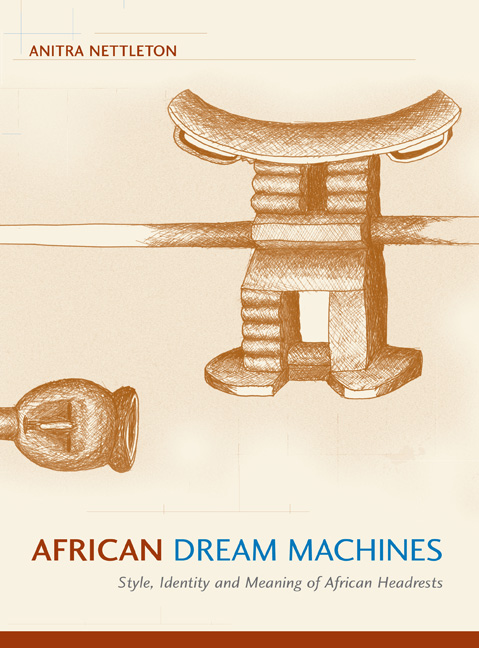Book contents
- Frontmatter
- Contents
- Preface
- Acknowledgements
- Notes on the Use of African Ethnic Names and Country and Place Names
- References to Illustrations in the Text and Notes on Illustrations
- Chapter 1 Headrests and Art
- Chapter 2 A Matter of Style, or, Why Style Matters
- Chapter 3 Methodology, Position and Limitations
- Chapter 4 The Geographical and Chronological Distribution of the Columned Headrest
- Chapter 5 Authenticity and History
- Chapter 6 East African Headrests: Identity, Form and Aesthetics
- Chapter 7 Tracing Histories: Central and Southern African Connections
- Chapter 8 Not Just a Curious Beauty: The Anatomy of Meaning in Useful Objects
- Notes to Chapters
- Bibliography
- List of Illustrations
- Index
Chapter 6 - East African Headrests: Identity, Form and Aesthetics
Published online by Cambridge University Press: 18 May 2019
- Frontmatter
- Contents
- Preface
- Acknowledgements
- Notes on the Use of African Ethnic Names and Country and Place Names
- References to Illustrations in the Text and Notes on Illustrations
- Chapter 1 Headrests and Art
- Chapter 2 A Matter of Style, or, Why Style Matters
- Chapter 3 Methodology, Position and Limitations
- Chapter 4 The Geographical and Chronological Distribution of the Columned Headrest
- Chapter 5 Authenticity and History
- Chapter 6 East African Headrests: Identity, Form and Aesthetics
- Chapter 7 Tracing Histories: Central and Southern African Connections
- Chapter 8 Not Just a Curious Beauty: The Anatomy of Meaning in Useful Objects
- Notes to Chapters
- Bibliography
- List of Illustrations
- Index
Summary
ALTHOUGH WE HAVE examined the single-columned headrest in many of its manifestations across the African continent, many other headrest types remain, some of which are constructed on design principles completely different from both the columned varieties. Many of these are very restricted in distribution, being made and used by one or two ethnic groups within particular linguistic clusters, while others have a widespread distribution across ethnic and linguistic boundaries. This chapter examines the patterns of distribution and collection of a variety of headrest types in the East African region.
The headrests from this region that have been most collected and documented in European museums are those that were made and used by peoples who speak Nilo- Saharan and Afro-Asiatic languages. The same collections contain very few examples from peoples who speak Niger-Congo languages, more particularly Bantu languages, in the East African region, encompassing the Sudan, Ethiopia, Somalia, Kenya, Uganda and Tanzania. This lack is somewhat peculiar, given that, although neither East nor Southern Africa is renowned for its figurative sculpture, headrests of various shapes and sizes made by Bantu language speakers in Central and Southern Africa were avidly collected, yet headrests made and used by East African speakers of Bantu languages are singularly sparse in European collections. This is probably not because these peoples had no tradition of hairstyling: Routledge and Routledge (1910), for example, give a careful and detailed description of the construction of hairstyles using bark, ochre and mud among the Kikuyu of Kenya, but make no mention of headrests or of woodcarving.
One mention of headrests made by Bantu speakers in Tanzania, made by Hore in his 1883 account of the territory's ‘twelve tribes’, speaks of the necessity for small wooden pillows to protect the elaborate hairstyles of the ‘Waguha’. But, while Hore does stop to give a description of Goma canoes, and proclaims them ‘triumphs of native African art’ (which, it must be noted, are not now preserved in museums, probably having been too large to transport easily to the colonial centre), he does not spend any further time on headrests (Hore 1883:14–15). A number of Ngoni headrests from Tanzania in Berlin are reproduced by Krieger (1990), but no others by Bantu speakers with a longer history of settlement there. These Ngoni headrests will, for historical and typological reasons, be treated with those of the Bantu speakers of Southern Africa.
- Type
- Chapter
- Information
- African Dream MachinesStyle, Identity and Meaning of African Headrests, pp. 187 - 244Publisher: Wits University PressPrint publication year: 2007

